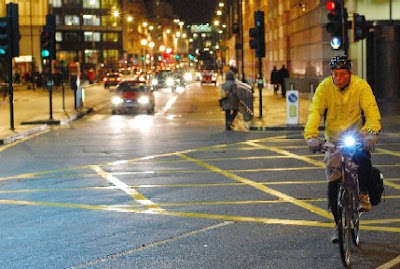 From the California Aggie (UC Davis), 02.28.07:
From the California Aggie (UC Davis), 02.28.07:Davis commemorates 50 years of bicyclingI was among the crowd that packed the Varsity Theatre in Davis on Monday night for Ted Buehler's presentation. Davis has a well-deserved reputation as the most bicyclist-friendly city in the U.S.
Even in a town reputed for its love of bicycles, Ted Bhueler (sic) stands out. On Monday night at the Varsity Theatre, Bhueler attracted a popcorn-munching, generation-spanning full-house audience that came to see a presentation based on the master's thesis Bhueler developed as a student at the UC Davis Institute of Transportation Studies. Entitled "50 Years of Bicycling in Davis, California," the thesis represents the culmination of two year's worth of interviews and studies, according to Bhueler.
"I was really surprised when I got here five years ago that so little research had been done on biking in Davis," said Bhueler's adviser Susan Handy, who explained that Bhueler's ITS- and CalTrans-funded project was intended to fill that gap.
In conducting his thesis, Bhueler claims that he found biking in Davis to be on a decline. Between 1990 and 2000, Bhueler found an 8 percent drop in individuals biking to and from work. This drop was partly attributed to a rise in the number of people commuting from out of town during that same period, and partly to new families moving to Davis. (Read more.)
However, many in Davis, including Buehler, feel the city has been coasting on its reputation. Following the completion of several large projects in the late 1990s, Davis has lagged in developing innovative new infrastructure to enhance bicycling. Other American cities, notably Boulder, Colorado, and Portland, Oregon, have made great strides this decade towards great bikeability. (And San Francisco--which pioneered the "sharrow" among other things--hasn't been a slacker either.)
Buehler was effective at demonstrating the importance of citizen advocacy in establishing the bicycle friendliness in Davis. "Why Davis and not some other city," Buehler offered, as the primary question of his research. It wasn't simply favorable climate, flat terrain, and abundance of university students. In 1960, according to Buehler, Davis had rates of bicycling mode share comparable to other college cities such as Corvalis, Oregon, and Chico, California. However, pushed by community activists, Davis made great strides by pioneering bike lanes, bike paths, and other cycling amenities, often pursuing changes in state traffic law to facilitate bicycling infrastructure development.
Having made numerous improvements--with a few failed experiments, having few precedents to draw upon--Davis today boasts admirable bicycling infrastructure. But have cyclists in Davis taken these conditions for granted? Is Davis' bikeability in jeopardy as the city grows and traffic increases? Will pro-bicycling residents react and reclaim Davis' reputation as the leading national innovator for bike facilities?
In his persuasive presentation to more than 300 people Monday evening, Buehler sounded a clarion call for renewed bicycling advocacy.
Image: Cottergarage
Visit: Paul Dorn's Bike Commuting Tips Site



.jpg)



